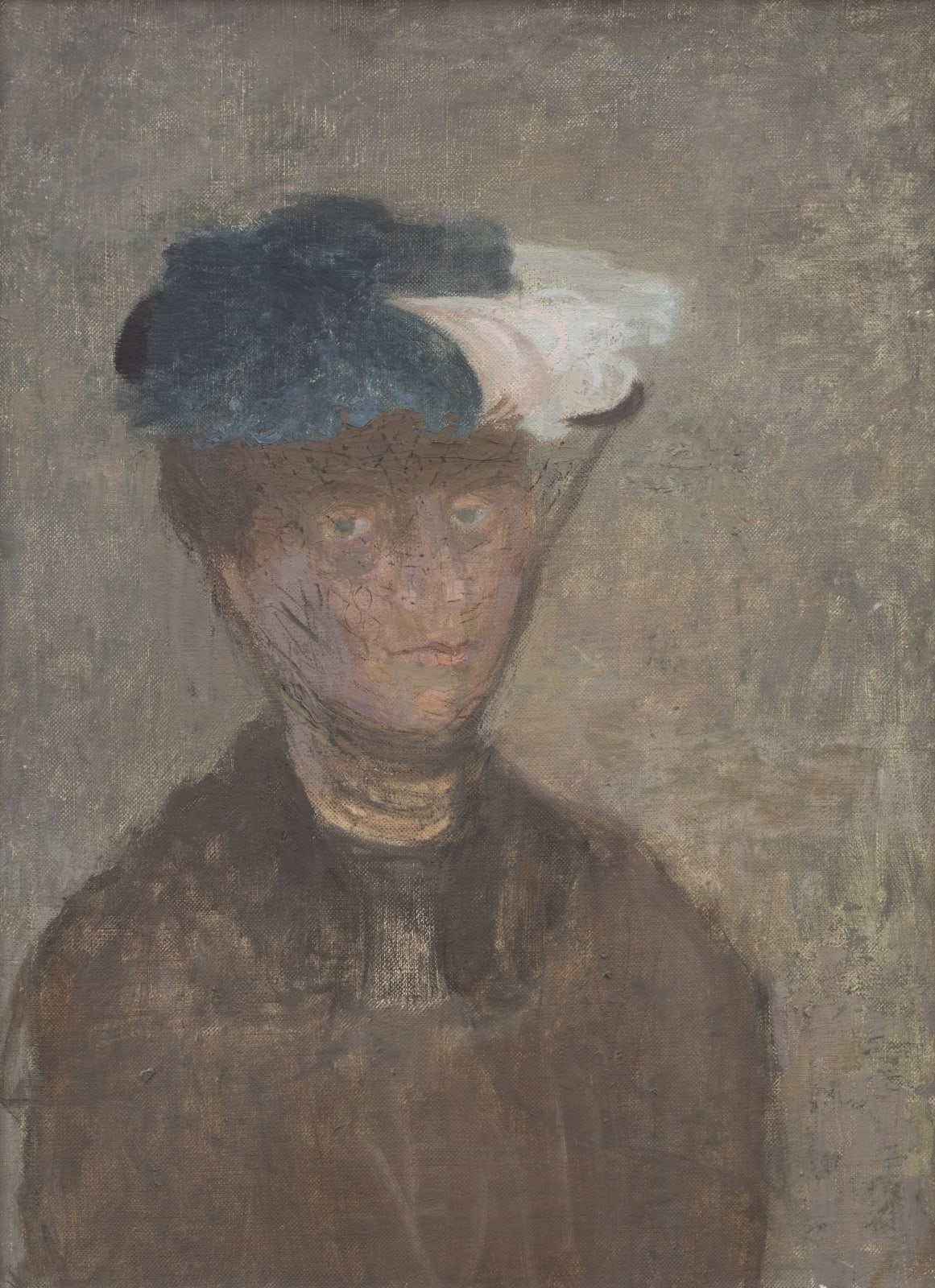Mary Potter
Self-Portrait in Hat, 1953
Oil on canvas
61 x 46 cm
24 1/8 x 18 1/8 in
24 1/8 x 18 1/8 in
Ruth Borchard Collection
This is a potent, critical self-portrait by the artist Mary Potter. She has depicted herself as a diminutive figure, set against an enveloping background of textured grey-brown brushwork. The ground...
This is a potent, critical self-portrait by the artist Mary Potter. She has depicted herself as a diminutive figure, set against an enveloping background of textured grey-brown brushwork. The ground of the picture is prominent, executed with a scabrous, open texture. In several places, the figure is so finely painted that the ground pushes through. Her torso, shrouded in dark clothing and a shawl, is largely composed from the underlying gauze of grey-brown paint. This effect of transparent layers was carefully calculated, and Potter also pursued the same idea in the veil of her fascinator. She has concealed herself in plain sight, layering her face beneath the streaks and patterns of the veil. This is a technically ingenuitive image of self-effacement, and Potter plays on the notion of revelation and concealment, at once showing herself and drawing back from the viewer's gaze.
The self-portrait was painted in 1953 at a moment when Potter's reputation was growing. Her work was widely displayed in this year, with an exhibition of watercolours at the Leicester Galleries and three works included in Famous British Women Artists, held at Graves Art Gallery, Sheffield. Several of her works were also acquired by public collections at this time, with the Arts Council purchasing The Erica House, Kew (1953) from her Leicester Galleries exhibition that year, among other examples. It was in this year that Potter moved with her family to Aldeburgh, Suffolk. Along with her husband and her children, she moved into The Red House - a picturesque house just a mile from the sea, a setting which caused a new wave of creativity in her output. As her son, Julian, has written, she 'felt she had the conditions to enable her to concentrate full time on her vocation' (Julian Potter, Mary Potter: a life of painting, Lund Humphries, 1998, p. 55).
Despite her growing creative powers at this time, Potter was struggling through a personal crisis. Her husband, Stephen, an author and erstwhile broadcaster with the BBC, was having an affair with a woman in London. Her name was Heather and for a period in 1952 and 1953 she refused to see Stephen, sending him into a torment of angst and rejection. This can perhaps be read from the mood of this self-portrait. By 1954, Heather and Stephen were seeing one another again and in the autumn of that year Stephen came to Mary and asked her to divorce him. A shadow of this betrayal is the subtext to this important self-portrait from 1953. The look that Potter shares with us in the picture is pregnant with meaning, a dazzling study in emotional explication.
The self-portrait was painted in 1953 at a moment when Potter's reputation was growing. Her work was widely displayed in this year, with an exhibition of watercolours at the Leicester Galleries and three works included in Famous British Women Artists, held at Graves Art Gallery, Sheffield. Several of her works were also acquired by public collections at this time, with the Arts Council purchasing The Erica House, Kew (1953) from her Leicester Galleries exhibition that year, among other examples. It was in this year that Potter moved with her family to Aldeburgh, Suffolk. Along with her husband and her children, she moved into The Red House - a picturesque house just a mile from the sea, a setting which caused a new wave of creativity in her output. As her son, Julian, has written, she 'felt she had the conditions to enable her to concentrate full time on her vocation' (Julian Potter, Mary Potter: a life of painting, Lund Humphries, 1998, p. 55).
Despite her growing creative powers at this time, Potter was struggling through a personal crisis. Her husband, Stephen, an author and erstwhile broadcaster with the BBC, was having an affair with a woman in London. Her name was Heather and for a period in 1952 and 1953 she refused to see Stephen, sending him into a torment of angst and rejection. This can perhaps be read from the mood of this self-portrait. By 1954, Heather and Stephen were seeing one another again and in the autumn of that year Stephen came to Mary and asked her to divorce him. A shadow of this betrayal is the subtext to this important self-portrait from 1953. The look that Potter shares with us in the picture is pregnant with meaning, a dazzling study in emotional explication.
Provenance
The Artist's EstateSubscribe for Updates and Events
* denotes required fields
We will process the personal data you have supplied to communicate with you in accordance with our Privacy Policy. You can unsubscribe or change your preferences at any time by clicking the link in our emails.
